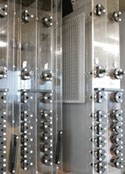More Productive Painting
Electrostatic separation cuts costs, energy use, environmental impact.
Continuous improvements in efficiency and quality, reduced energy consumption, minimized emissions—these are the metrics by which the success of automotive and other high-volume paint shops are measured.
Paint system supplier Eisenmann Corporation (Crystal Lake, IL) says its newly developed electrostatic separation system for paint overspray can help painters achieve their productivity and conservation goals by reducing waste, cutting operating costs and minimizing environmental impact.
The E-Scrub system directs air in the spray booth so that surplus paint mist (overspray) produced during painting is routed via funnel-shaped run-off surfaces known as flood sheets into a new electrostatic separation system. Part of the overspray is immediately bound using a separating agent on the flood sheets, while the bulk of the paint material continues through the electrostatic separation portion of the system.
The separation process begins in “separating modules” at the bottom of the flood sheets. The high-voltage modules are fitted with positively charged separating plates which are also rinsed with separating agent in a circulating system. High-voltage wires also run horizontally between the separating plates inside the module. Paint particles in the circulating air stream become negatively charged as they pass near the high-voltage wires and are attracted by the positively charged separating plates. They are then bound by the separating agent and discharged into a bottom-mounted collecting pan. According to Eisenmann, the chemical composition of the separating agent causes bound paint particles to combine in the collecting pan and form solid agglomerates, which can then be removed and disposed of without difficulty.
The company says electrostatic charging of paint overspray particles and binding of overspray in the separating agent maximizes collection efficiency, enabling the system to meet stringent air quality requirements. The German clean air regulation “Technical Instructions on Air Quality Control” (commonly known as TA Luft), for example, permits maximum dust emissions of 3 mg/m3. According to Eisenmann, the E-Scrub system can cut emissions to well below the regulation, to 0.3 mg/m3.
The system operates with 95% recirculated air. Eisenmann says this results in energy savings of up to 78% compared with conventional wet scrubber technology, as well as an 87% reduction in water usage and considerably reduced chemicals usage. The electrostatic system switches on and off in accordance with production, yielding further energy savings.
Electrostatic paint overspray separation improves paint quality by eliminating complex mechanical filtration systems and ensuring constant flow rates without pressure fluctuations, Eisenmann says. The system is also said to be considerably quieter and easier to service than mechanical systems, with fewer components than conventional wet scrubber systems. It can be retrofitted quickly and simply in existing paint plants.
Related Content
-
NASF/AESF Foundation Research Project #122: Electrochemical Approaches to Treatment of PFAS in Plating Wastewater - 10th Quarterly Report
The NASF-AESF Foundation Research Board selected a project addressing the problem of PFAS and related chemicals in plating wastewater streams. This report covers the 10th quarter of work (April-June 2023). Here, we examine the effect of surface fluorination of Ti4O7 anodes on PFAS degradation performance in terms of energy performance as well as formation of chlorate and perchlorate when chloride is present in the solution. The full paper on this work can be accessed and printed at short.pfonline.com/NASF24Feb2.
-
NASF/AESF Foundation Research Project #120: Electrochemical Destruction of Perfluorooctanesulfonate in Electroplating Wastewaters - April 2022-March 2023
This NASF-AESF Foundation research project report covers project work from April 2022 to March 2023 at the University of Illinois at Chicago. The overall objective of this work is to utilize a cost-effective reactive electrochemical membrane (REM) for the removal of PFAS from synthetic electroplating wastewater. Initial results for the oxidation of PFOA with three different catalysts are discussed.
-
Hubbard-Hall Acquires BioConversion Technology
The acquisition adds experience and biologics to the AquaPure product line.

















